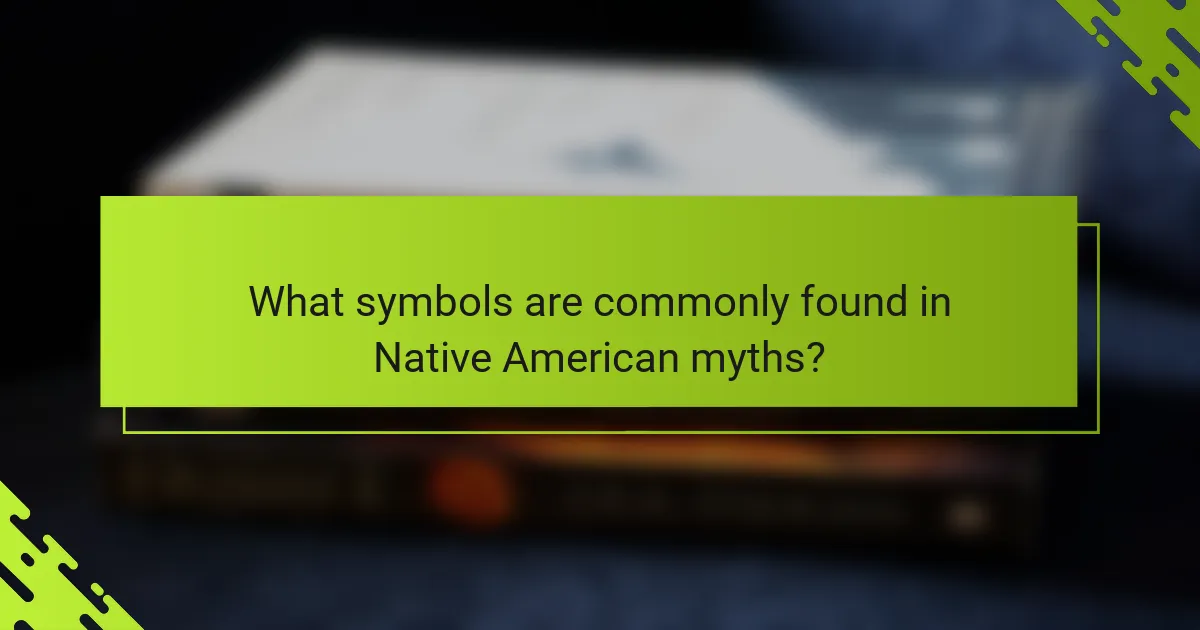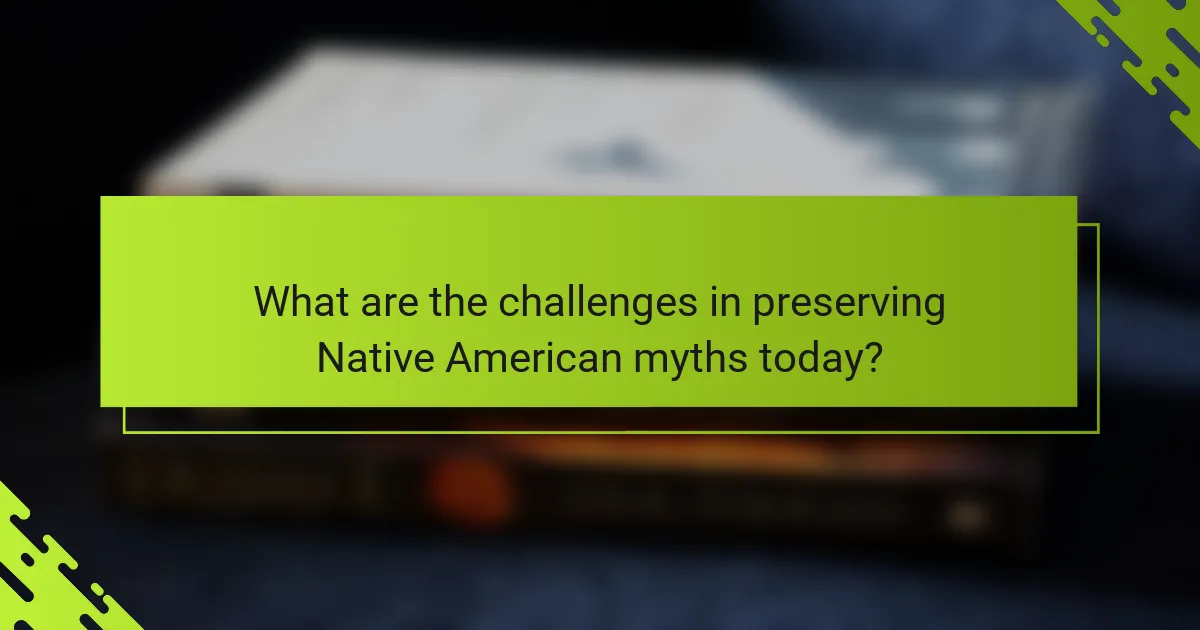Native American myths offer valuable insights into nature, spirituality, and community. They feature common symbols like animals and celestial bodies that convey deep cultural significance. These narratives provide moral lessons and reflect contemporary issues such as identity and environmentalism. Understanding these myths enhances appreciation for the interconnectedness of life and the importance of cultural preservation.

What are the foundational themes in Native American myths?
Foundational themes in Native American myths include nature, spirituality, and community. These myths often emphasize the interconnectedness of all living beings. Nature serves as a central entity, reflecting cultural values and environmental respect. Spirituality manifests through creation stories and moral lessons. Community is highlighted in tales that reinforce social bonds and collective identity. These themes remain relevant, influencing modern interpretations and fostering a deeper understanding of Native American cultures.
How do these themes reflect cultural values and beliefs?
Native American myths reflect cultural values and beliefs by conveying moral lessons and emphasizing the interconnectedness of life. These stories often highlight respect for nature, community, and spirituality. For example, many myths illustrate the importance of harmony with the environment, showcasing the belief that all beings are interconnected. Additionally, the symbolism in these tales serves to preserve history and traditions, reinforcing a sense of identity and belonging among Native American communities. Modern interpretations of these myths continue to resonate, adapting their lessons to contemporary issues while maintaining their core values.
Why is storytelling significant in Native American traditions?
Storytelling is significant in Native American traditions because it preserves culture, imparts wisdom, and fosters community. Myths convey essential values and lessons, often using symbolism to reflect the relationship between humans and nature. These stories serve as educational tools, teaching generations about morality, respect for the earth, and the interconnectedness of all life. Modern interpretations of these myths continue to resonate, adapting to contemporary contexts while maintaining their core messages. This adaptability highlights storytelling’s unique ability to bridge past and present, ensuring cultural continuity.

What symbols are commonly found in Native American myths?
Common symbols in Native American myths include animals, natural elements, and celestial bodies. Animals often represent traits or lessons, such as the bear for strength or the owl for wisdom. Natural elements like water and fire symbolize life and transformation. Celestial bodies, including the sun and moon, convey themes of cycles and time. Each symbol carries deep cultural significance, reflecting the values and beliefs of various tribes.
How do symbols convey deeper meanings?
Symbols in Native American myths convey deeper meanings by representing complex concepts and values. These symbols often embody lessons about nature, humanity, and spirituality. For example, the eagle symbolizes strength and freedom, while the circle represents unity and the cyclical nature of life. Such imagery allows for multifaceted interpretations, reflecting cultural beliefs and practices. Modern interpretations continue to explore these symbols, revealing their relevance in contemporary discussions about identity and environmental stewardship.
Which animals are frequently represented and what do they signify?
Commonly represented animals in Native American myths include the eagle, wolf, bear, and turtle. Each signifies unique qualities; for instance, the eagle symbolizes vision and freedom, while the wolf represents loyalty and intelligence. The bear is often seen as a protector and signifies strength, and the turtle embodies wisdom and longevity. These animals convey essential lessons about nature and humanity’s relationship with the world.

What lessons can be derived from Native American myths?
Native American myths offer profound lessons about respect for nature, community values, and the interconnectedness of life. These stories often emphasize moral teachings, such as the importance of humility and the consequences of greed. Myths like those of Coyote or Spider Woman illustrate human flaws and virtues, providing guidance on personal conduct and societal harmony. Modern interpretations reveal their relevance today, as they inspire movements for environmental stewardship and cultural preservation.
How do these lessons apply to contemporary life?
Native American myths offer valuable lessons that remain relevant in contemporary life. These stories emphasize interconnectedness, respect for nature, and the importance of community. Modern interpretations highlight the need for sustainability and cultural preservation. By applying these lessons, individuals can foster a deeper understanding of their relationship with the environment and each other. Embracing such wisdom can guide ethical decision-making and promote harmony in diverse communities.
Why are moral teachings important in these stories?
Moral teachings in Native American myths are crucial as they impart essential life lessons. These stories often emphasize values such as respect for nature, community, and the interconnectedness of all beings. By conveying morals through symbolism and narrative, these myths guide individuals in making ethical decisions. As a result, they foster cultural identity and continuity, reinforcing the importance of wisdom passed through generations.

How have Native American myths evolved over time?
Native American myths have evolved significantly, reflecting cultural changes and contemporary values. Historically, these myths served to explain natural phenomena and teach moral lessons. Over time, they have adapted to modern contexts, incorporating new themes and interpretations.
Today, Native American myths often address contemporary issues such as identity, environmentalism, and social justice. This evolution highlights the resilience of these narratives and their capacity to resonate with current audiences. As a result, they continue to be a vital part of cultural expression and education.
What influences have shaped modern interpretations?
Modern interpretations of Native American myths are shaped by historical contexts, cultural exchanges, and contemporary values. These influences include the impact of colonization, which altered traditional narratives, and the rise of movements advocating for indigenous rights and recognition. Additionally, popular media and literature have reimagined these myths, often blending them with modern themes. This evolution reflects a dynamic interplay between preserving cultural heritage and adapting to current societal issues, ensuring that the lessons within these myths remain relevant.
Which myths have gained prominence in popular culture?
Native American myths have significantly influenced popular culture through storytelling, symbolism, and lessons. These myths often emphasize harmony with nature, the importance of community, and spiritual connections. Modern interpretations have adapted these themes into literature, film, and art, showcasing the depth and richness of Native American heritage. For instance, films like “Avatar” draw heavily on Native American beliefs about nature and interconnectedness. Such representations highlight the enduring relevance of these myths in contemporary society, promoting awareness and appreciation of cultural diversity.

What are the unique attributes of specific tribal myths?
Native American myths possess unique attributes that reflect cultural values and environmental connections. These myths often embody lessons about harmony with nature, community, and spirituality. For instance, the creation stories frequently highlight the importance of land and animals. Additionally, symbols like the trickster figure serve to convey moral lessons, illustrating the complexities of human behavior. Modern interpretations of these myths continue to evolve, integrating contemporary issues while preserving their core messages.
How do the myths of the Navajo differ from those of the Lakota?
Navajo myths often focus on harmony with nature and the importance of balance, while Lakota myths emphasize bravery and the spirit of the warrior. Both cultures convey deep spiritual lessons, yet their unique attributes shape distinct narratives. Navajo stories frequently explore themes of creation and healing, representing their connection to the land. In contrast, Lakota myths celebrate the valor of ancestors and the significance of communal identity, reflecting their historical experiences. These differences highlight the diverse ways Native American cultures interpret life’s challenges and values.
What rare myths exist that are less known but hold significance?
Several rare Native American myths convey profound symbolism and lessons. One example is the story of the “Sky Woman,” who represents creation and balance in nature. Another is the “Coyote and the Buffalo,” illustrating themes of humility and respect for life. The “Great Flood” myth varies among tribes, emphasizing resilience and renewal. Each of these myths holds modern interpretations that highlight environmental stewardship and cultural identity. Such stories often reflect unique attributes of specific tribes, showcasing their distinct values and beliefs.

How do Native American myths address environmental themes?
Native American myths often emphasize the interconnectedness of nature and humanity, highlighting environmental themes. These narratives convey lessons about respect for the earth, sustainability, and the consequences of human actions. For instance, many myths feature animals as central characters, symbolizing the importance of biodiversity and ecological balance.
Furthermore, these stories often include themes of harmony, illustrating how humans should live in accordance with natural cycles. The teachings encourage stewardship of the land and caution against exploitation, reflecting a unique attribute of Native American culture that prioritizes environmental responsibility.
Modern interpretations of these myths continue to resonate, inspiring contemporary movements focused on ecological preservation and indigenous rights. As a result, Native American myths remain relevant in addressing today’s environmental challenges.
What role does nature play in these narratives?
Nature plays a central role in Native American myths, symbolizing interconnectedness and offering lessons about harmony. These narratives often illustrate how natural elements reflect spiritual beliefs and cultural values. For instance, animals and plants serve as totems, representing traits that guide moral behavior. Additionally, landscapes are depicted as sacred spaces, reinforcing the importance of environmental stewardship. Modern interpretations highlight the relevance of these lessons in addressing contemporary ecological challenges.
How can these myths inform modern environmental practices?
Native American myths can guide modern environmental practices by emphasizing respect for nature and sustainability. These stories often highlight interconnectedness among all living beings, fostering a sense of responsibility towards the environment. For instance, many myths advocate for conservation, teaching that overexploitation leads to imbalance.
Additionally, the symbolic lessons found in these narratives encourage community-oriented approaches to environmental stewardship. By integrating traditional ecological knowledge with contemporary science, modern practices can become more holistic and effective. This fusion can enhance biodiversity and promote sustainable resource management.
Ultimately, these myths serve as reminders that a harmonious relationship with nature is essential for future generations. They inspire a shift towards practices that honor both cultural heritage and environmental integrity.

What are the challenges in preserving Native American myths today?
Preserving Native American myths today faces significant challenges, including cultural appropriation and loss of language. These myths are often misrepresented in popular culture, leading to a distortion of their meanings. Additionally, the decline in traditional storytelling practices threatens the transmission of these narratives to future generations. The impact of modernization further complicates efforts to maintain these cultural treasures.
How does cultural appropriation affect these stories?
Cultural appropriation often distorts Native American myths, leading to misrepresentation and loss of authenticity. It can strip these stories of their original meanings and significance, resulting in superficial interpretations. This appropriation undermines the cultural heritage of Native communities and perpetuates stereotypes. As a result, it is essential to approach Native American myths with respect and an understanding of their cultural context.
What efforts are being made to keep these traditions alive?
Efforts to preserve Native American myths include educational programs, cultural festivals, and digital archiving. These initiatives aim to promote understanding and appreciation of these traditions. Organizations collaborate with tribes to document stories and symbols, ensuring they are passed to future generations. Community workshops engage younger members, fostering a connection to their heritage.
What best practices can be followed to respect and honor these narratives?
To respect and honor Native American myths, one should prioritize cultural sensitivity and authenticity. Engaging with Native communities directly fosters understanding and respect for their narratives. Incorporating traditional storytelling methods preserves the essence of these myths. Supporting Native artists and scholars ensures accurate representation and interpretation. Additionally, educating oneself about the historical context enhances appreciation for the lessons embedded in these stories.
